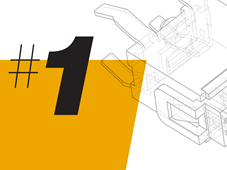Medical Device Design: Are You Building A Product Or An Experience?
 By Roger Bohannan | November 11, 2019
By Roger Bohannan | November 11, 2019

This is an excerpt from the medical white paper Designing the Ultimate Operator Experience. For the full white paper, download here.
When an OEM is creating a family of products, they will typically want a universal ‘look and feel’ – the DNA of the brand, if you like. There are various ways to achieve this. For example, you can make sure every member of a product family shares the same design, colour scheme or branding elements – to convey consistency and wholeness as a family. But there is also another, even more effective way to achieve this… through the switch.
As the primary interface between the device and the operator, the switch offers a way to set a standard. The ‘feel’ when operating a switch is referred to as haptics (based on the science and physiology of the human sense of touch) and making this feel consistent across all the switches in a range can both improve the user experience and send signals regarding brand quality and reliability.
The critical importance of haptics can be perfectly summed up by this anecdote from a leading manufacturer of electro-surgery instruments. ‘When we proposed potentially replacing a series of double-action key switches on the device, the surgeons came back and told them they would not use the product without that specific component due to its particular tactile feel.
— Roger Bohannan, Medical Segment Leader at C&K
The potential for both switch haptics and acoustics in the modern medical application is exciting. Take an insulin pen, for example. When you design this device with an electromechanical interface, you are characterizing the sound and force used to actuate medicine delivery. This sensation can transform the experience – from quiet and peaceful to a shock – very quickly.
Likewise, if you are designing a laparoscopic closure and detach tool, the haptic sensations give the medical professional a positive confirmation that the device has performed as expected – a surgeon will depend on the tactile feedback from their electro-surgery instruments before cutting and sealing tissue. The feel of the capture of the vessel comes with the travel of a switch. The sound and feel of closure come with a sound and a tactile feel of an actuating medical switch. Even the detach feature comes with a slightly higher force and more impressive sound. Those differences enable medical professionals to know exactly what is happening at the end of this advanced procedure, supporting the best patient outcome.
A correctly specified and engineered switch can make a crucial difference not only to the sound and feel that mirror the performance, but to the levels of reassurance provided to the user. This can be a vital consideration, and one that we’ve seen in the field to be the determining factor for whether a device is used and relied upon or ultimately abandoned.
